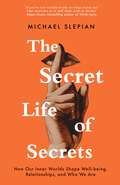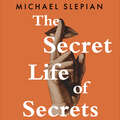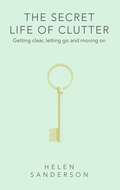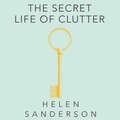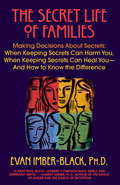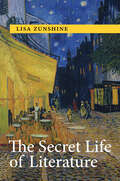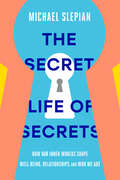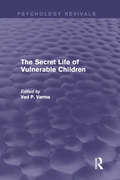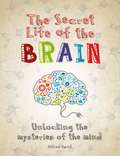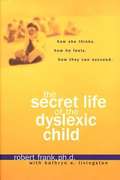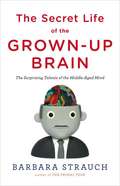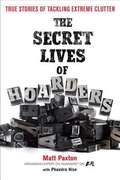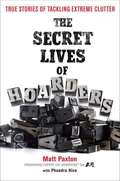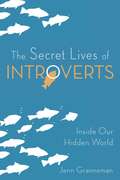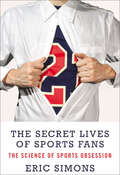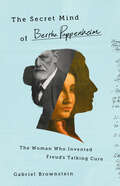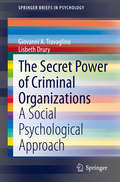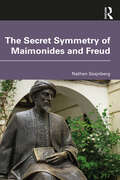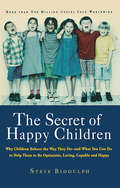- Table View
- List View
The Secret Life Of Secrets: How Our Inner Worlds Shape Well-being, Relationships, and Who We Are
by Michael SlepianAn eye-opening look at why we keep the secrets we keep, how to better understand and cope with them, and when (and how) we should bring them to light.Think of a secret that you're keeping from others. It shouldn't take long. Psychologist Michael Slepian finds that, on average, we are keeping as many as thirteen secrets at any given time. His research, involving more than 50,000 participants from around the world, shows that we most frequently keep secrets about lies we've told, ambitions, addictions, mental health challenges, hidden relationships and financial struggles.Our secrets can weigh heavily upon us. Yet the burden of secrecy rarely stems from the work it takes to keep a secret hidden. Rather, the weight of our secrets comes from carrying them alone. Whether we are motivated to protect our reputation, a relationship, a loved one's feelings, or some personal or professional goal, one thing is clear: holding back some part of our inner world is often lonely and isolating. But it doesn't have to be. Filled with fresh insight into one of the most universal - yet least understood - aspects of human behaviour, The Secret Life of Secrets sheds fascinating new light on questions like: At what age do children develop the cognitive capacity for secrecy? Do all secrets come with the same mental load? How can we reconcile our secrets with our human desires to relate, connect and be known? When should we confess and to whom? And can keeping certain types of secrets actually enhance our well-being? Drawing on over a decade of original research, this book reveals the surprising ways in which secrets pervade our lives, and offers science-based strategies that make them easier to live with. The result is a rare window into the inner workings of our minds, our relationships and our sense of who we are.
The Secret Life Of Secrets: How Our Inner Worlds Shape Well-being, Relationships, and Who We Are
by Michael Slepian'If you've ever wondered why we keep secrets and what motivates us to spill them, look no further' Adam Grant, #1 New York Times bestselling author of Think AgainAn eye-opening look at why we keep the secrets we keep, how to better understand and cope with them, and when (and how) we should bring them to light.Think of a secret that you're keeping from others. It shouldn't take long. Psychologist Michael Slepian finds that, on average, we are keeping as many as thirteen secrets at any given time. His research, involving more than 50,000 participants from around the world, shows that we most frequently keep secrets about lies we've told, ambitions, addictions, mental health challenges, hidden relationships and financial struggles.Our secrets can weigh heavily upon us. Yet the burden of secrecy rarely stems from the work it takes to keep a secret hidden. Rather, the weight of our secrets comes from carrying them alone. Whether we are motivated to protect our reputation, a relationship, a loved one's feelings, or some personal or professional goal, one thing is clear: holding back some part of our inner world is often lonely and isolating. But it doesn't have to be. Filled with fresh insight into one of the most universal - yet least understood - aspects of human behaviour, The Secret Life of Secrets sheds fascinating new light on questions like: At what age do children develop the cognitive capacity for secrecy? Do all secrets come with the same mental load? How can we reconcile our secrets with our human desires to relate, connect and be known? When should we confess and to whom? And can keeping certain types of secrets actually enhance our well-being? Drawing on over a decade of original research, this book reveals the surprising ways in which secrets pervade our lives, and offers science-based strategies that make them easier to live with. The result is a rare window into the inner workings of our minds, our relationships and our sense of who we are.
The Secret Life of Babies
by Mia Kalef Andrew FeldmarA bold affirmation that we are sentient before conception and in the womb, The Secret Life of Babies reveals author Mia Kalef's groundbreaking findings: babies are able to remember their earliest experiences, this consciousness precedes the physical development of the brain itself, and medical interventions during birth--like forceps and Cesareans--can imprint our relationships with the world and disconnect us from our sustainable place in the ecosystem. Kalef provides a six-step protocol for detecting these individual imprints and taking reparative steps for physiological and emotional balance and release. This book offers us an articulate guide to a transformation that can restore our essential nature. From the table of contents:Foreword by Andrew FeldmarIntroduction: The Myth: Science and Experience The Quest: Sparking the Conversation Who Is This Book For? A Song Worth SingingPART ONE: ScienceChapter 1: The First Principle: Babies Remember Their Experiences The Controversy A Place to Begin and End: Returning to Wholeness Essential Nature Essential Movements The Mechanisms The Model Perspectives and PurposesChapter 2: The Second Principle: Consciousness Precedes the Brain Architecture That Supports It The Biological Paradox Brains, Fields, and Development The Effects of Chemical and Emotional FieldsChapter 3: The Third Principle: Babies Are Our Barometers Dominance versus Emergence Historical Cultural Indicators Present-Day Cultural IndicatorsPART TWO: ExperienceChapter 4: The Fourth Principle: It Is Never Too Late to Heal The Vision Horizon Preparing the Way Reclaiming the Body: The Path Home The PrototypePART THREE: MarriageChapter5: The Intuitive Recovery Project The Anatomy of the Intuitive Recovery Project The ProjectChapter 6: SummaryFrom the Trade Paperback edition.
The Secret Life of Clutter: Getting clear, letting go and moving on
by Helen SandersonWhen you get clear about why your clutter is holding you back, you can finally let it go and create the home you love.Our homes have fascinating stories to tell. The spaces we inhabit and the objects within them reflect many aspects of our lives and our inner selves. In The Secret Life of Clutter, ten intimate and touching stories take you on a profound journey as people discover what their cluttered homes reveal about their lives, and make life-changing shifts when they start to let go and move on. The secret to creating a calm and nurturing home is to uncover the psychological reasons that lie beneath your clutter, and to understand that what is blocking you in your home and your life is often the key to moving forwards. Unlocking some of the meaning your possessions may hold can free you to say goodbye to what you no longer need, whilst keeping your precious memories intact. The insights revealed in this book will help you understand some of the factors that may be sabotaging your efforts to make more space. It will inspire you to take action and create a home that you love, that loves you back - a home that reflects who you are and the life you want to live.You'll never look at your clutter - or your home - the same way again.
The Secret Life of Clutter: Getting clear, letting go and moving on (Language Acts and Worldmaking #13)
by Helen Sanderson'A thoughtful and surprisingly emotional account of our complex relationship with stuff ... If you don't want your possessions to possess you, then this is a book you must read' Graham AllcottWhen you get clear about why your clutter is holding you back, you can finally let it go and create the home you love.Our homes have fascinating stories to tell. The spaces we inhabit and the objects within them reflect many aspects of our lives and our inner selves. In The Secret Life of Clutter, ten intimate and touching stories take you on a profound journey as people discover what their cluttered homes reveal about their lives, and make life-changing shifts when they start to let go and move on. The secret to creating a calm and nurturing home is to uncover the psychological reasons that lie beneath your clutter, and to understand that what is blocking you in your home and your life is often the key to moving forwards. Unlocking some of the meaning your possessions may hold can free you to say goodbye to what you no longer need, whilst keeping your precious memories intact. The insights revealed in this book will help you understand some of the factors that may be sabotaging your efforts to make more space. It will inspire you to take action and create a home that you love, that loves you back - a home that reflects who you are and the life you want to live.You'll never look at your clutter - or your home - the same way again.
The Secret Life of Families: When Keeping Secrets Can Harm You, When Keeping Secrets Can Heal You--And How to Know the Difference
by Evan Imber-BlackSecrets come in all shapes and sizes. And for families as well as individuals, they are built on a complex web of shifting motives and emotions. But today, when personal revelations are posted on the Internet or sensationalized on afternoon talk shows, we risk losing touch with how important secrets are--how they are used and abused, their power to harm and heal. In this important work, Evan Imber-Black explores the nature of secrets, helping us understand: The distinction between healthy privacy and toxic secrecy What to tell--and not to tell--young children How to safely confront a family "zone of silence" Why adolescents need to have some secrets--and where to draw the line The effect of "official" secrets, like sealed adoption records and medical testing What to consider before revealing an important secret And much more Filled with moving first-person stories,The Secret Life of Familiesprovides perspective on some of today's most sensitive personal and social issues. Giving voice to our deepest fears and to our power to overcome them, this is a book that will be talked about for years to come.
The Secret Life of Literature
by Lisa ZunshineAn innovative account that brings together cognitive science, ethnography, and literary history to examine patterns of &“mindreading&” in a wide range of literary works.For over four thousand years, writers have been experimenting with what cognitive scientists call &“mindreading&”: constantly devising new social contexts for making their audiences imagine complex mental states of characters and narrators. In The Secret Life of Literature, Lisa Zunshine uncovers these mindreading patterns, which have, until now, remained invisible to both readers and critics, in works ranging from The Epic of Gilgamesh to Invisible Man. Bringing together cognitive science, ethnography, and literary studies, this engaging book transforms our understanding of literary history. Central to Zunshine&’s argument is the exploration of mental states &“embedded&” within each other, as, for instance, when Ellison&’s Invisible Man is aware of how his white Communist Party comrades pretend not to understand what he means, when they want to reassert their position of power. Paying special attention to how race, class, and gender inform literary embedments, Zunshine contrasts this dynamic with real-life patterns studied by cognitive and social psychologists. She also considers community-specific mindreading values and looks at the rise and migration of embedment patterns across genres and national literary traditions, noting particularly the use of deception, eavesdropping, and shame as plot devices. Finally, she investigates mindreading in children&’s literature. Stories for children geared toward different stages of development, she shows, provide cultural scaffolding for initiating young readers into a long-term engagement with the secret life of literature.
The Secret Life of Secrets: How Our Inner Worlds Shape Well-Being, Relationships, and Who We Are
by Michael Slepian&“If you&’ve ever wondered why we keep secrets and what motivates us to spill them, look no further. Michael Slepian has spent the past decade studying the psychology of secrets, and is ready to reveal his findings to the world.&”—Adam Grant, #1 New York Times bestselling author of Think Again Think of a secret that you&’re keeping from others. It shouldn&’t take long; behavioral scientist Michael Slepian finds that, on average, we are keeping as many as thirteen secrets at any given time. His research involving more than 50,000 participants from around the world shows that the most common secrets include lies we&’ve told, ambitions, addictions, mental health challenges, hidden relationships, and financial struggles.Our secrets can weigh heavily upon us. Yet the burden of secrecy, Slepian argues, rarely stems from the work it takes to keep a secret hidden. Rather, the weight of our secrets comes from carrying them alone, without the support of others. Whether we are motivated to protect our reputation, a relationship, a loved one&’s feelings, or some personal or professional goal, one thing is clear: Holding back some part of our inner world is often lonely and isolating. But it doesn&’t have to be.Filled with fresh insight into one of the most universal—yet least understood—aspects of human behavior, The Secret Life of Secrets sheds a fascinating new light on questions like: At what age do children develop the cognitive capacity for secrecy? Do all secrets come with the same mental load? How can we reconcile our secrets with our human desires to relate, connect, and be known? When should we confess our secrets? Who makes for the ideal confidant? And can keeping certain types of secrets actually enhance our well-being?Drawing on over a decade of original research, Slepian reveals the surprising ways that secrets pervade our lives, and offers science-based strategies that make them easier to live with. The result is a rare window into the inner workings of our minds, our relationships, and our sense of who we are.
The Secret Life of Vulnerable Children (Psychology Revivals)
by Ved P. VarmaHow do disturbed children see the world? How can we understand their difficulties? Most children have secret worlds but for some these worlds contain secrets that are both permanent and damaging. Originally published in 1992, this moving account of the secret lives of such vulnerable and disturbed children will enable professionals working with these children to find out what is going on in their minds – what they are thinking, what they are feeling, why they behave as they do. The contributors, all experts in their field at the time, show how vulnerable children can be assessed and how they can be helped most effectively.
The Secret Life of the Brain (Secret Life Of Ser.)
by Alfred DavidIn the long history of the study of anatomy, neuroscience is a relatively new field, and there are plenty of mysteries yet to be uncovered. The Secret Life of the Brain explores the fascinating advances that have been made in the field so far, from the intricacies of memory and intelligence, to the enigmatic workings behind our sense of humour and our dreams. Full of illuminating illustrations and diagrams, this book lifts the lid on how drugs affect the brain; the science behind addiction; how the brain deals with trauma and pain; and the effects on the brain of love, age, and sex. Finally, you'll get a tantalising insight into the cutting-edge theories that are attempting to get behind the elements of neuroscience which we still can't quite explain.
The Secret Life of the Brain (Secret Life of)
by Alfred DavidIn the long history of the study of anatomy, neuroscience is a relatively new field, and there are plenty of mysteries yet to be uncovered. The Secret Life of the Brain explores the fascinating advances that have been made in the field so far, from the intricacies of memory and intelligence, to the enigmatic workings behind our sense of humour and our dreams. Full of illuminating illustrations and diagrams, this book lifts the lid on how drugs affect the brain; the science behind addiction; how the brain deals with trauma and pain; and the effects on the brain of love, age, and sex. Finally, you'll get a tantalising insight into the cutting-edge theories that are attempting to get behind the elements of neuroscience which we still can't quite explain.
The Secret Life of the Dyslexic Child: How She Thinks. How He Feels. How They Can Succeed
by Robert Frank Kathryn E. Livingstonfrom the book jacket Dr. Robert Frank, whose own dyslexia didn’t stop him from becoming an educator, psychologist, and author, takes you inside the emotions and frustrations of children with learning disorders. In Part One, you’ll discover what your child never told you about: How your child’s mind works What your child is feeling The separate worlds of “Us” and “Them” In Part Two, you'll walk in your child’s shoes to see for yourself: * What it’s like to think like a dyslexic * What it feels like to be different * The emotions that can disrupt your child’s progress * How to bridge the gap between your child and others In Part Three, you’ll get a clear picture of: * The diagnosis of learning disorders * How your reaction affects your child In Part Four, you’ll receive expert advice to: * Establish goals for your child * Create a game plan for success, * Work better with teachers * Boost self-esteem * Find success at school, at home, in life Your child isn’t dumb. Your child isn’t lazy. Your child is dyslexic, and needs your help. Your child may need help reading and writing, but more than that, he needs you" to understand him. Now you can, as you. go inside the emotional life of children with learning differences. In The Secret Life of the Dyslexic Child, you’ll finally discover what your child goes through every day You will come to under-1 stand his struggles with things you take for granted, such as reading, writing, memory, and following directions. What’s more, you will learn, step by step, the best ways to help him reach his true potential.
The Secret Life of the Grown-up Brain: The Surprising Talents of the Middle-aged Mind
by Barbara StrauchA leading science writer examines how the brain's capacity reaches its peak in middle age. For many years, scientists thought that the human brain simply decayed over time and its dying cells led to memory slips, fuzzy logic, negative thinking, and even depression. But new research from neuroscientists and psychologists suggests that, in fact, the brain reorganizes, improves in important functions, and even helps us adopt a more optimistic outlook in middle age. Growth of white matter and brain connectors allow us to recognize patterns faster, make better judgments, and find unique solutions to problems. Scientists call these traits cognitive expertise and they reach their highest levels in middle age. In her impeccably researched book, science writer Barbara Strauch explores the latest findings that demonstrate, through the use of technology such as brain scans, that the middle-aged brain is more flexible and more capable than previously thought. For the first time, long-term studies show that our view of middle age has been misleading and incomplete. By detailing exactly the normal, healthy brain functions over time, Strauch also explains how its optimal processes can be maintained. Part scientific survey, part how-to guide, The Secret Life of the Grown-Up Brain is a fascinating glimpse at our surprisingly talented middle-aged minds.
The Secret Life of the Mind: How Your Brain Thinks, Feels, and Decides
by Mariano SigmanFrom a world-renowned leader in neuroscience, a provocative, enthralling journey into the depths of the human mind.Where do our thoughts come from? How do we make choices and trust our judgments? What is the role of the unconscious? Can we manipulate our dreams? In this mind-bending international bestseller, award-winning neuroscientist Mariano Sigman explores the complex answers to these and many other age-old questions. Over the course of his 20-year career investigating the inner workings of the human brain, Dr. Sigman has cultivated a remarkable interdisciplinary vision. He draws on research in physics, linguistics, psychology, education, and beyond to explain why people who speak more than one language are less prone to dementia; how infants can recognize by sight objects they've previously only touched; how babies, even before they utter their first word, have an innate sense of right and wrong; and how we can "read" the thoughts of vegetative patients by decoding patterns in their brain activity. Building on the author's awe-inspiring TED talk, the cutting-edge research presented in The Secret Life of the Mind revolutionizes how we understand the role that neuroscience plays in our lives, unlocking the mysterious cerebral processes that control the ways in which we learn, reason, feel, think, and dream.
The Secret Lives of Hoarders
by Matt PaxtonOn the front lines with extreme hoarders The Secret Lives of Hoarders is much more than harrowing tales of attacking the ugliest, dirtiest, and most shocking hoarding cases in the country. It is a behind-the-scenes look at this hidden epidemic- what it means, how to recognize it before it gets out of hand, and how to deal with it. Through his work with hundreds of clients in the worst circumstances- from the giant "rat's nest" that hid more than $13,000 in cash to a vast cache of cartoon pornography to twenty-five years' worth of unopened mail-Matt Paxton has learned to understand this disorder and his clients' impulses to collect, to speak the hoarders' language, and to reach out to them with compassion and concern while avoiding criticism and judgment. Most important, he guides compulsive hoarders successfully through every step of the clean-up and healing process. The Secret Lives of Hoarders is an engrossing and sometimes unsettling look at extreme clutter but one that helps hoarders, their families, and their friends to find meaning in the chaos. .
The Secret Lives of Hoarders: True Stories of Tackling Extreme Clutter
by Matt Paxton Phaedra HiseOn the front lines with extreme hoarders, The Secret Lives of Hoarders is much more than harrowing tales of attacking the ugliest, dirtiest, and most shocking hoarding cases in the country. It is a behind-the-scenes look at this hidden epidemic--what it means, how to recognize it before it gets out of hand, and how to deal with it. Through his work with hundreds of clients in the worst circumstances-from the giant 'rat's nest' that hid more than $13,000 in cash to a vast collection of mermaid pornography to twenty five years' worth of unopened mail--Matt Paxton has learned to understand this disorder and his clients' impulses to collect, to speak the hoarders' language, and to reach out to them with compassion and concern while avoiding criticism and judgment. Most important, he guides compulsive hoarders successfully through every step of the cleanup and healing process. The Secret Lives of Hoarders is an engrossing and sometimes unsettling look at extreme clutter but one that helps hoarders, their families, and their friends find meaning in the chaos.
The Secret Lives of Introverts: Inside Our Hidden World
by Adrianne Lee Jenn GrannemanAn introvert guide and manifesto for all the quiet ones—and the people who love them. Is there a hidden part of you that no one else sees? Do you have a vivid inner world of thoughts and emotions that your peers and loved ones can’t seem to access? Have you ever been told you’re too "quiet,” "shy,” "boring,” or "awkward”? Are your habits and comfort zones questioned by a society that doesn’t seem to get the real you? If so, you might be an introvert.On behalf of those who have long been misunderstood, rejected, or ignored, fellow introvert Jenn Granneman writes a compassionate vindication-exploring, discovering, and celebrating the secret inner world of introverts that, only until recently, has begun to peek out and emerge into the larger social narrative. Drawing from scientific research, in-depth interviews with experts and other introverts, and her personal story, Granneman reveals the clockwork behind the introvert’s mind-and why so many people get it wrong initially.Whether you are a bona fide introvert, an extrovert anxious to learn how we tick, or a curious ambivert, these revelations will answer the questions you’ve always had: What’s going on when introverts go quiet? What do introvert lovers need to flourish in a relationship? How can introverts find their own brand of fulfillment in the workplace? Do introverts really have a lot to say-and how do we draw it out? How can introverts mine their rich inner worlds of creativity and insight? Why might introverts party on a Friday night but stay home alone all Saturday? How can introverts speak out to defend their needs?With other myths debunked and truths revealed, The Secret Lives of Introverts is an empowering manifesto that guides you toward owning your introversion by working with your nature, rather than against it, in a world where you deserve to be heard.
The Secret Lives of Sports Fans: The Science of Sports Obsession
by Eric SimonsSports fandom is either an aspect of a person's fundamental identity, or completely incomprehensible to those who aren't fans at all. What is happening in our brains and bodies when we feel strong emotion while watching a game? How do sports fans resemble political junkies, and why do we form such a strong attachment to a sports team? Journalist Eric Simons presents in-depth research in an accessible and brilliant way, sure to interest readers of Jonah Lehrer and Malcolm Gladwell. Through reading the literature and attending neuroscience conferences, talking to fans, psychologists, and scientists, and working through his issues as part of a collaboration with the NPR science program RadioLab, Eric Simons hoped to find an answer that would explain why the attractive force of this relationship with treasured sports teams is so great that we can't leave it.
The Secret Mind of Bertha Pappenheim: The Woman Who Invented Freud's Talking Cure
by Gabriel BrownsteinThe story of a patient who changed the world, and the mystery of her illness. In 1880, young Bertha Pappenheim got strangely ill—she lost her ability to control her voice and her body. She was treated by Sigmund Freud&’s mentor, Josef Breuer, who diagnosed her with &“hysteria.&” Together, Pappenheim and Breuer developed what she called &“the talking cure&”—talking out memories to eliminate symptoms. Freud renamed her &“Anna O&” and appropriated her ideas to form the theory of psychoanalysis. All his life, he told lies about her. For over a century, writers have argued about her illness and cure. In this unusual work of science, history, and psychology, Brownstein does more than describe the controversies surrounding this extraordinary woman. He brings Pappenheim to life—a brilliant feminist thinker, a crusader against human trafficking, and a pioneer—in the hustling and heady world of nineteenth-century Vienna. At the same time, he tells a parallel story that is playing out in leading medical centers today, about patients who suffer symptoms very much like Pappenheim&’s, and about the doctors who are trying to cure them—the story of the neuroscience of a condition now called FND.The Secret Mind of Bertha Pappenheim argues for the healing art of listening and describes the new &“talking cures&” emerging out of neuroscience today.
The Secret Of The Golden Flower: A Chinese Book of Life (International Library Of Psychology Ser.)
by Wilhelm, RichardFirst Published in 1999. Routledge is an imprint of Taylor & Francis, an informa company.
The Secret Power of Criminal Organizations: A Social Psychological Approach (SpringerBriefs in Psychology)
by Giovanni A. Travaglino Lisbeth DruryThis Brief presents a social psychological approach to understanding the reaction of communities to organized crime and illegal groups. Based on a new theoretical framework and the latest empirical evidence, this book explores questions of how criminal organizations are able to gain power and exert governance over entire territories. This book draws on the prototypical example of Italian organized crime and analyzes the thesis that the power of criminal groups is grounded in dynamics of legitimization rather than fear or coercion. The compliance of a community is seen here as stemming from the endorsement of specific cultural values and norms. These cultural values are actively appropriated, mobilized and transmitted by criminal groups, a dynamic the authors have labeled Intracultural Appropriation Theory. The book emphasizes what can be learned from using this emerging theory in similar settings such as those of terrorist groups and violent gangs, and points the way to solutions for this social problem.
The Secret Power of Middle Children
by Salmon Catherine Katrin SchumannMiddle children are underachievers, overshadowed and overlooked, right? Wrong. Combining research in evolutionary biology, psychology and sociology with real-life stories, psychologist Catherine Salmon, Ph. D. , and journalist Katrin Schumann reveal what it really means to grow up in between, including how:• Middles receive less financial and emotional support from their parents, but become remarkably successful and innovative adults• Middles can be stubbornly independent as teens, but are extraordinary team players later in life• Middles are often seen as outcasts, but are actually far less likely to get divorced or be in therapy than their siblings. With surprising insights into how our birth order affects us, as well as constructive advice on how to maximize advantages and overcome drawbacks, The Secret Power of Middle Children shows middleborns at any age (and their parents) how to use what seems to be a disadvantage as a strategy for personal and professional success. .
The Secret Strength of Depression, Fifth Edition: Newly Revised with Updated Information on the Treatment for Depression Including Medications
by Frederic FlachThe Secret Strength of Depression--a self-help classic which has helped millions suffering from depression to no longer feel trapped in stigma and shame--is now updated with new information on current and emerging medications and alternative therapies.The Secret Strength of Depression is a timeless, enduring self-help work that still offers invaluable insight on the subject of depression some 40 years after its original publication. This new edition includes the latest information on medications, alternative therapies, and more.Author Dr. Frederic Flach was one of the pioneers in the study of biology and depression and established the groundwork for the understanding of human resilience. Dr. Flach's positive, informative approach showed that, by tapping into their creative energy, an individual could turn their depression into a powerful force for personal growth.
The Secret Symmetry of Maimonides and Freud
by Nathan SzajnbergThe Secret Symmetry of Maimonides and Freud presents the parallels between The Guide of the Perplexed and The Interpretation of Dreams, considering how Maimonides might be perceived as anticipating Freud’s much later work. The Secret Symmetry of Maimonides and Freud suggests that humankind has secrets to hide and does so by using common mechanisms and embedding revealing hints for the benefit of the true reader. Using a psychoanalytic approach in tandem with literary criticism and an in-depth assessment of Judaica, Szajnberg demonstrates the similarities between these two towering Jewish intellectual pillars. Using concepts of esoteric literature from the Torah and later texts, this book analyses their ideas on concealing and revealing to gain a renewed perspective on Freud’s view of dreams. Throughout, Szajnberg articulates the challenges of reading translated works and how we can address the pitfalls in such translations. The book is a vital read for psychoanalysts in training and practice, as well as those interested in Judaica, the history of ideas, and early medieval studies.
The Secret of Happy Children: Why Children Behave the Way They Do--and What You Can Do to Help Them to Be Optimistic, Loving, Capa
by Steve BiddulphPsychologist and family counselor Steve Biddulph has been hailed as a "childhood guru" (The Guardian) and a "publishing phenomenon" (the Times, London), and this is his landmark book, the foundation for his major international reputation. <P><P>With unparalleled clarity, common sense, and warmth, The Secret of Happy Children instructs all parents about parent-child communication from babyhood to teens. It gives parents confidence to be more themselves as parents—stronger, more loving, more definite, more relaxed. Biddulph reveals what is really happening inside kids' minds and what to do about it. <P>He covers a wide variety of issues important to a child's—and a parent's—happiness, including stopping tantrums before they begin, curing shyness, the link between food and behavior, and much more. Parents will find themselves letting go of old, negative approaches and freeing up more energy to enjoy their kids and their own lives.
